A Photographer’s Thoughts on Zoo Exhibit Design
I’m a photographer, not a zoological park architect, but I’m writing about zoo habitat design here because I spend a reasonable amount of time photographing critters in them (be it to test out new gear or techniques, practice and hone skills, or simply do something fun for a day). It’s been my experience as a visitor at various zoos, and especially as a photographer, that a good visual design for an enclosure results in a more pleasing and engaging experience for me as a guest.
Certainly, from a wildlife photography perspective, zoos aren’t the final objective; getting out in the field is. However, for many, especially non-professionals, zoos are the only real access able way to see and photograph many exotic species. More importantly, they provide a reasonably accessible place to train and hone wildlife photography skills on real animals.
Designers, who I hope may end up reading this, are provided with guidance from zoological associations, like the Association of Zoos and Aquariums (AZA), in the from of species care manuals. These manuals provide designers with recommended minimums for much of the mechanical requirements for safely containing the animals, but don’t really go into details on the presentation.
My intention here is to look at the visual design and aspects of enclosure design, from the perspective of a guest, and specifically as a photographer. None of this is intended to be a hard rule of any sort, but I will focus on some aspects that, to me at least, don’t really appear to be well considered. Of course, given that I’ve never been involved in zoo design, I could be entirely wrong and they may be considered and ignored for other reasons.
I feel like I ought to put a little context to this post. I started writing this just after Zoo Miami opened Florida: Mission Everglades and I had just seen it. Prior to Flroida: Mission Everglades Zoo Miami opened a Amazon exhibit that made extensive use of modern design trends to create a seamless and naturalistic environment, then came Mission Everglades and its woefully disappointing design. At the time I was frustrated, and started writing something that was little more than a rant. But as good as rants may feel to rant, they don’t actually help anything. So I’ve tried to take my frustrations, and mold them into something that was more constructive.
Redefining Presentation: Disney Takes on Zoos
We’ve come a long way from the small steel bared cages that were the norm for zoos in the early 20th century. Zoos have increasingly recognized that providing animals with space to roam and engage in natural behaviors makes for healthier animals.
When Disney opened their Animal Kingdom theme park, at least from the point of view of a guest and photographer, they completely changed the game as far as what a zoo should look like.
Disney’s imagineers, perhaps uniquely, have a strong background in thinking about presentation in a theatrical sense when designing pretty much all of their attractions. It’s simply not acceptable to have mechanical and supporting systems stand out in an obvious way.
Moreover, since Disney’s approach is to take you away from being in a theme park, and visually transport you to somewhere else — be it a magical fairyland, or sub-Saharan Africa — their designers placed a strong emphasis on making everything feel right, at least visually.
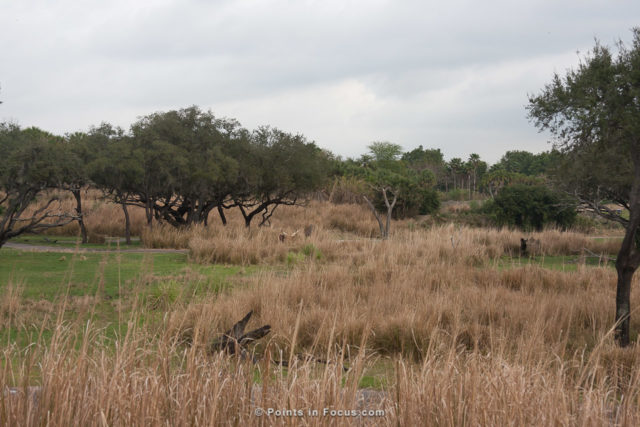
Disney’s Animal Kingdom, Kilimanjaro Safari Ride
The above image shows the kind of thought process Disney’s Imagineers work with. While the environment is dramatically condensed compared to the Maasai Mara, the Okavango, or the bush of somewhere like Kruger National Park, the overall look is strongly reminiscent.
Another example, on the the Gorilla Falls Exploration Trail, the Lowland gorilla are displayed in a densely canopied area, very much representative of the tropical and subtropical primary and secondary forests where they’re found in the wild. The exhibit space it self, is further sculpted to look natural — at least more natural than some flat grass surrounded by a moat — including some elevation changes and plantings and sculpted “rock” walls. The moats that separate the guests from the gorillas are styled to look like rivers with waterfalls feeding them. Even the steel pipes that form a barrier along one area, are style and painted to look like bamboo.
That’s not to say that there aren’t compromises in places at Disney’s Animal Kingdom. There certainly are places where wire mesh barriers exist, and are visible. Likewise, if you look carefully you can see a stand of palms in the background of the above image as well. Though even there, Disney’s designers go to length to control where those barriers are and how visible they are to the guests (as will be illustrated later).
Additionally, there are places where attempting to achieve perfect replication of a natural habitat is an unnecessary cost and difficulty. Central Florida, and really even South Florida, gets much colder than equatorial Africa does. That can affect the choices for landscaping materials. Moreover, using plant species native, or at least already introduced, to the locale of the zoo is going to be preferable when ever practical.
For example, even though baobab trees can survive in at least some parts of Florida[1], all (or at least the vast majority) of the Baobab trees in Animal Kingdom’s enclosures are fake; concrete facsimiles that fool the visitor’s eye (and camera) but require virtually no maintenance and have no risk of dying or spreading.
Likewise, Disney makes extensive use of what to my eye looks like local North American grasses as basic ground cover in their Kilimanjaro Safari ride instead of African Red grass (Themeda triandra) that would be found on the Maasai Mara and Serengeti grasslands.
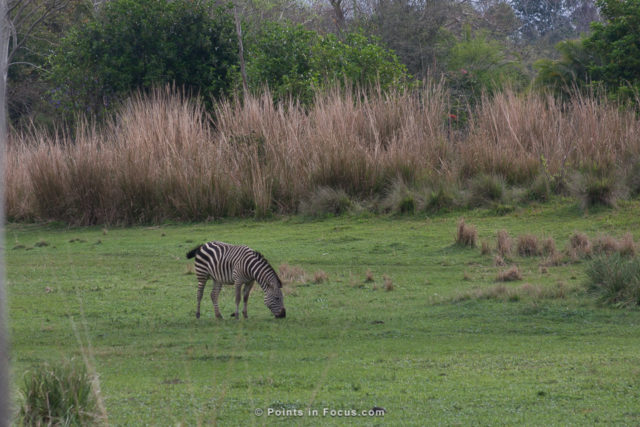
Disney’s Animal Kingdom, Kilimanjaro Safari Ride
Does the end result look identical to the Maasai Mara, Serengeti, Okavango, or Kruger National Park? No, not at all. However, it does capture the feel, and more importantly, it doesn’t look like they’ve dropped some zebra into an enclosure that looks like someone’s front yard and garden.
From the perspective of a guest and photographer, Disney’s Animal Kingdom park set a benchmark standard for the way I want to see animals presented in zoos.
Zoo Miami’s: Amazon and Beyond
Zoo Miami seemed to get this when they did their first major expansion in back in 2008. The Amazon and Beyond exhibit employed many of the design practises that Disney used in their Animal Kingdom.
In fact, one of my first observations with the Amazon and Beyond exhibit when it opened was how well Zoo Miami did at emulating the pattern Disney laid out with Animal Kingdom. The entire area is heavily forested such that it feels like being in a tropical rain forest. The paths are generally windy and sight lines are controlled, as a result the area feels larger than it actually is (~4.3 acres, 1.76 hectares of exhibit space based on my measurements from satellite imagery). Moreover, for the most part, containment structures are mostly designed to not draw attention to themselves, at least to the extent that was reasonable. They even duplicated the steel pipes disguised as bamboo trick.
That’s not to say Amazon and Beyond is perfect. It’s not, but it’s reasonably good.
That said, Amazon and Beyond is a good example of the kinds of compromises that need to be made in designing enclosures.
Probably my biggest complaint is that the jaguar enclosure is difficult to photograph. However, it’s also clear to see where the decisions make sense from a perspective of managing containment. Jaguars are powerful climbers, and the AZA’s recommendations for containing them is to have them in a fully enclosed structure (source).
If possible, institutions are recommended to completely enclose the top of any jaguar enclosure.
However, if jaguars are to be housed in an open-topped enclosure, dry moats should have a width of no less than 7.62 m (25 ft), and vertical jump walls at least 4.57 m (15 ft) high are recommended. Cantilevered supports with mesh or fencing material with an attached hot-wire is recommended for open-top fenced exhibits.
However, while I would rather not have to view or photograph through wire mesh, not having it requires a significant increase in viewing distance due to the size of the required moats. That in turn poses some problems, as jaguars are not very big “big cats”. Jaguars typically are between 3.7–6.1 feet (1.12–1.85 m), where a Sumatran tiger (one of the smallest tiger subspecies, and the subspecies that Zoo Miami keeps), are between 7.25–8.34 feet (2.2–2.55 m) long.
Generally speaking, closer is better; both for regular visitors viewing and for photography. More importantly, having to have a large (25 foot, 7.62 m) moat not only adds to the viewing distance, it can dramatically increase the required size of the enclosure. The moats around Zoo Miami’s tiger enclosure almost double the depth of the enclosure (50 feet in moats, around a 60 foot wide island).
However, even when mesh is necessary the implementation can and does make a big difference. For starters, black coated wire meshes tend to be less distracting, at least if implemented well. However, a lot still depends on controlling light falling on the meshes and the brightness of the background behind it.
Under the dense canopy of the Amazon and Beyond exhibit, most of the black mesh around the jaguar enclosure isn’t that visually distracting, though there are places where light falls on it and it becomes significantly more visible. That said, from a photography perspective, the mesh does have an impact on the resulting images as evidenced by the oddly patterned out of focus blurs in the following image.
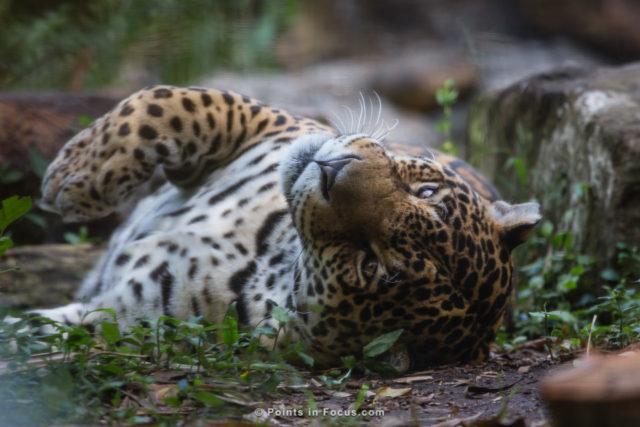
Note the somewhat odd background blurring due to the wire mesh.
An Argument for More Natural Enclosures
Ignoring my own self serving desires, better photography. I would argue that there is a large benefit to having natural looking enclosures in the primary mission of the zoo; educating the public. Natural environment designs provide context to help explain where the animals come from and how they’ve adapted.
Big cats for example have evolved colorations and camouflage patterns that allow them to blend in to the environments around them. A lion’s color is a close approximation of the brown grasses that predominate much fo the areas the inhabit. The same can be said about the rather plane tan/brown of Florida panthers. The stripes and spots of tigers, leopards, jaguars and so on, mimic the mottled shadows and highlights of undergrowth.
When these animals are displayed in an environment that mimics the natural landscape, people get a better appreciation for how they live and where they could be found. Given that one of the primary intents of zoos is to inform and educate people on animals and their environment, this aligns very strongly with that objective.
Beyond that, there’s a level of inherent enrichment and security that a natural looking habitat can provide the animal. Both being factors that improve the animals quality of life compared to even simple grassed enclosures.
It’s not like I’m out in left field suggesting something strange or insane. The AZA animal care manuals for most species suggests that enclosures should be designed to be as natural as possible. The following quote comes from the AZA’s lion care manual.
The best lion exhibits safely replicate the features of the lion’s natural habitat. This will encourage natural behaviors, which will result in healthier animals and provide an educational and inspirational experience for zoo guests. Lions
are territorial animals that patrol and protect a well-defined area from intrusion by other conspecifics. In the wild, territorial borders are typically marked with scent, and this behavior is also seen in zoos. Lions are largely terrestrial, and do best when maintained outdoors, at least during warmer weather, in large spacious enclosures designed to encourage species-appropriate behaviors such as resting, walking, hunting, stalking, grooming, playing, breeding, etc. (Schaller, 1972).Enclosures should be planted with grasses and bushes for visual privacy from guests and conspecifics, trees for shade, and include various substrates, surfaces to mark, deadfall for scratching, and other
aspects in their enclosure that will change their pathways and create complex behavioral opportunities.
This varied topography will help create multi-leveled pathways that may reduce development of
stereotypic behaviors such as pacing.
Zoo Miami’s Florida: Mission Everglades
Presentation, specifically a natural looking one, is where I feel that Mission Everglades falls down massively.
In some real ways it felt to me like Zoo Miami went to the other end of the Disneyfication spectrum with Florida: Mission Everglades. The centerpiece of the area is a ride. The Lostmans River Ride, is an open air old mill style ride. Boats travel around a flume like path and provide views of several of the enclosures. The Lostmans River Ride while themed appropriately for the everglades — ride boats are styled to look like airboats — the ride itself imposes other constraints on the attraction as a whole.
Don’t get me wrong, I’m not trying to be a stick in the mud who says there shouldn’t be rides at zoos. However, I couldn’t help but feel as I was walking around Florida: Mission Everglades that the designers felt the ride was the focal point and not the animals.
Now I do have to concede, a lot of the Everglades isn’t the most inspiring area when it comes to terrain. The vast majority of it is a featureless river of Sawgrass dotted occasionally with cypress domes. There’s no appreciable undulation to the terrain, no water falls, no appreciable interesting rock formations, and no river gorges.
However, much of that open sawgrass isn’t the ideal habitat for most of the species being displayed either. Though they’ll certainly use it in the wild, many of the species in the exhibit are more typically found in more forested areas and cypress domes. Panthers, for example are most frequently found in pine lands, hardwood hammocks, and swamp forests where there is shelter and concealment. All of those environments offer interesting potential for landscaping and designing an enclosure, that is more natural looking than a flat grass covered pen. I would even go so far as to speculate that part of the teething problems Zoo Miami was having with getting their panther to come out during the day could potentially be related to the habitat design and the lack of established shade and concealment.
The other cat exhibit in Florida: Mission Everglades is in many ways even worse than the panther enclosure. The bobcat enclosure in a lot of ways looks more like someone’s front yard, with neatly planted butterfly gardens than the kinds of natural habitats where bobcats can be found.
To make a long story short, at least as far as I’m concerned, Florida: Mission Everglades is a massive disappointment, and I was so hopeful that it would be wonderful. The Florida panther, bobcat, and Florida black bear exhibits are hampered by distracting fencing[2] and design; including especially poor backgrounds. Likewise, the American alligator exhibit’s water feature looks more like a concrete pool than a natural body of water.
What I found maybe more frustrating, is that at least in my experience with the panther and bobcat enclosures, was that the fencing was less distracting when looking through my camera, even though it made for very poor images, than when just observing them with my naked eye.
Presentation and Habitat Design Through the Eyes of a Photographer
When it comes to designing habitats and enclosures for pretty much any of the animals that zoos keep there are of course all kinds of priorities. Security and safety, both of the public and the animals contained, are of course paramount. After safety and security, I would argue that presentation should be a major consideration, as it’s fundamental to the mission of zoos to inform and educate people on the animals in their care.
The following discussion is my musing on what I’ve found works well as a guest and photographer not necessarily a complete guide for zoo designers.
That said, I want to note, that while I may be talking about creating more naturalistic enclosures that are better for viewing and photography, I don’t think the enclosures need to be 100% representative of the wild. We are still talking about zoos, and it seems perfectly reasonable to me that images made in them shouldn’t completely look like images made in the wild.
Cameras, Lenses, and Viewing Distances
One of the general rules in photography is, the closer you are the better the picture will be. Which is to say if I don’t have to use an 800mm lens with a 2x teleconverter to get a shot, I’m going to be better off. That said, how close that needs to be is going to be dictated by the size of the animal in question and the containment systems needed to safely house it.
Truthfully the same can be said about viewing things with the naked eye too. The closer you are the more you can appreciate the thing you’re looking at.
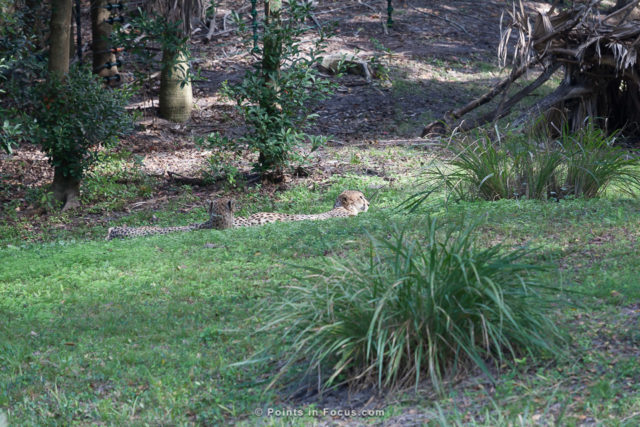
Disney’s Animal Kingdom, Kilimanjaro Safari Ride
Take for example, the above image of the cheetahs (as well as the image in the following section) at Animal Kingdom’s Kilimanjaro Safari attraction as a perfect example of this. Both of those images were made with a 280mm focal length[3], at in excess of 100 feet. Though I didn’t have to crop either, they’re both at the upper ends of what I consider reasonable for most people.
Of course, the kinds of camera gear that guests both photographers and non-photographers are likely to bring spans a pretty large range. Professional and serious amateur photographers, especially wildlife photographers, will have lenses with significant focal length allowing them to make tight compositions of just an animal’s head at extreme distances. Conversely, many normal visitors will likely be using their smart phone with it’s wide angle lens that will render everything looking small and far away.
So with that said, what kind of equipment might be reasonable to expect and how does that correspond to reasonable viewing distances.
In my experience, most hobbyist photographers who are generally interested in photography but not specialized in wildlife photography will have a 200-300mm zoom lens on an APS-C format camera. This will provide an 8 foot horizontal field of view at 68–102 feet (20.7–31.1 m) depending on the specific focal length.
With this in mind, something like Sumatran Tiger some 30-40 feet away on the other side of a moat, would be reasonably in the realm of something that a typical hobbyist photographer could capture decent images of with typical consumer gear.
Backgrounds
Photographically speaking distracting backgrounds are literally an eye-sore and take away from the subject being photographed. There are basically two potential problems here; backgrounds that fail to mask other stuff, and backgrounds that just become distracting.
I’ll start with backgrounds that fail to mask and separate what’s behind them. This can range in problems from simply making the images look like they were token in a zoo (not necessarily a bad thing), to becoming significantly distracting. In most cases, what I find so frustrating about this is in many cases, the issues could be quickly addressed by planting a hedge, bamboo, or even just climbing vines on a fence.
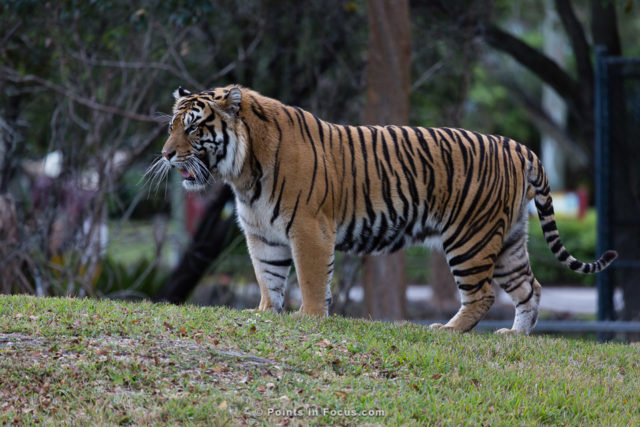
Zoo Miami
In the example image above, you can clearly see the walkway in the background, along with a high fence that surrounds some utilities. Further note, in this example, the area between the exhibits rear fence line (horizontal gray bar just above the grass) and the concrete path in the background is not intended for viewing the exhibit; there are signs posted along that walkway telling guests no to go into that area.
That said, if you were to pan over to the left from the above picture a couple of degrees, the area beyond the fence line is heavily masked with bamboo which makes a much more attractive background and masks any people walking along the path well behind the exhibit.
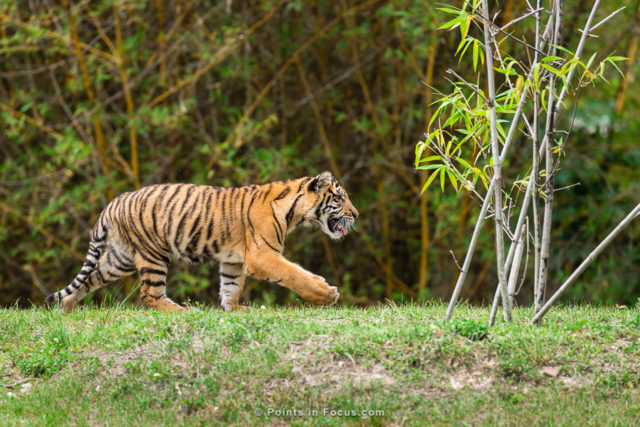
Zoo Miami
The second issue is when there is something in the background that’s itself is inherently distracting. Chain link fences, especially when they’re uncoated galvanized steel ones are especially distracting. The structural elements (posts and top rails) are very obvious not distinctly natural looking, and the mesh itself produces a odd visual patter when out of focus.
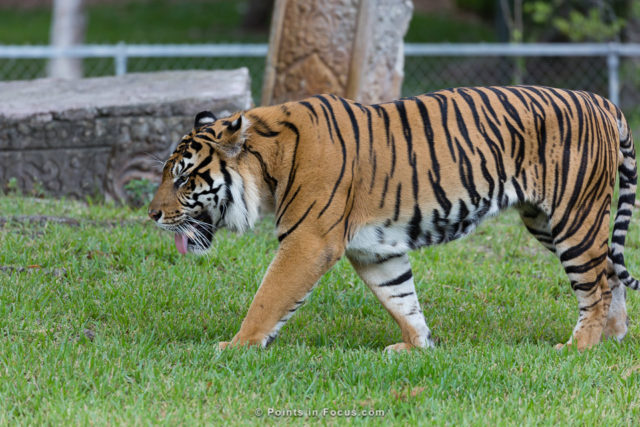
Zoo Miami
However, had that fence simply been dark green or black, it would have been far less obvious or distracting.
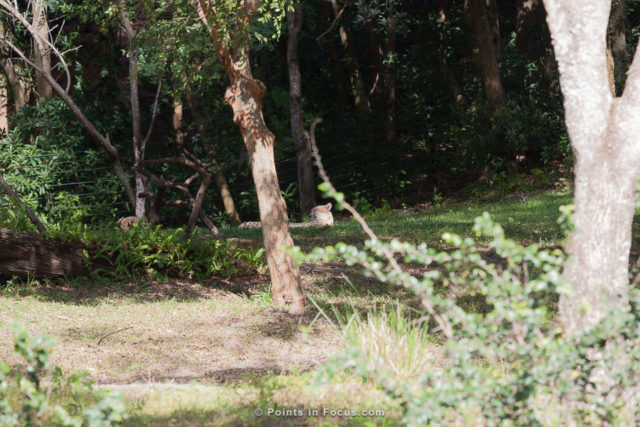
Disney’s Animal Kingdom, Kilimanjaro Safari Ride
Actually this is a good example of the kind of thing that Disney’s Animal Kingdom does well. There is a fence in the above image, but you’ll notice that the fence uses dark green/black coated wire. That immediately makes it significantly less noticeable. However, Disney’s designers too things a setup further, and placed the fence line in shade and against dense plant growth, which further conceals the unnatural looking wire.
The same can be said about the Animal Kingdom cheetah image shown in the previous section. There is a fence line along the top of the image. However, Disney’s Imaginer’s choice of materials, placement, and control of light and shade, make it difficult to see.
Containment: Moats, Glass, and Fences
From both the perspective of a photographer and as just a guest, having an unobstructed view of the animals being displayed is ideal. Of course, this ideal is not something that’s always possible to achieve either. Obviously the over reaching concern here is going to be properly and safely containing the animals in question.
Generally though, my preference as a guest is that containment be done with a moat, such that the grade of the exhibit itself can be at the same grade as the walkways guests use.
That said, not all animals can be easily contained with just a moat. Moreover, either due to overall space constraints or the size of the animals, it’s entirely possible that a moat of sufficient size to meet the safety requirements would place the animal far enough away from the guests as to significantly reduce ability of guests to view it.
Switching to mesh or fenced containment mechanism imposes a number of secondary design considerations that should be considered. Meshes, even black coated ones, still reflect incident light. This can be extremely distracting to guest trying to view the exhibit. As I pointed out previously, an example I found of this was Zoo Miami’s Florida Panther exhibit. So much light fell on the mesh at the front of the cage it was hard not to see it clearly.
While I won’t go so far as to say that the objective should always be to design an exhibit such that it would produce natural looking images. Having harsh, distracting, or difficult to view through containment isn’t really desirable either.
Grading
In my experience, the most visually successful enclosures are graded so there is a rising slope from the front of the enclosure to the rear. This has the effect of limiting some sight lines from the viewer so that they don’t see, or see as much, of the rear moat and various support structures.
This is more of a consideration for larger enclosures where slight grades and reasonable distances can be used to good effect to conceal support structures behind the exhibit.
Obviously grading can’t solve all problems, and in small enclosures would require potentially unnaturally steep grades.
Shade, Shadow, and Light
Perhaps one of the biggest advantages that Disney’s designers had when designing Animal Kingdom’s exhibits, was their background in theatrical productions. Virtually every ride at Disney can be though of, in terms of lighting at least, as a theatrical production. Light is placed, or allowed to fall, where the subject matter is and carefully masked away from the areas that are to be hidden.
Admittedly this is easier to do inside a building as opposed to in an open environment, however, even then Disney’s designers have carefully designed things to make the best use of light and shadow.
I would go back to the images I posted earlier of the fence lines in Disney’s Kilimanjaro Safari attraction. Where ever practical Disney’s Imagineers placed fence lines where they would be in the shade as opposed to openly lit by the sun. Both cameras, and the human eye, are limited in the range between bright and dark that can be seen at these same time.
In the case of human vision, the brain is extremely good at combining multiple “exposures” form the eye into a single perceived image. That said, even then there are limits to just what kind of magic the brain can do. Moreover, the entire experience can be controlled to some extent by controlling the relationship between the primary subject and the areas that are to be hidden.
For example, trees may never be able to shade a fence line enough to render it impossible to see. However, if the primary focus is on an animal that’s not in the shade at all, even a moderate amount of shade can be enough. The effect can be further boosted by using a dark colored fencing (black or dark green), and a random patterned background say of leaves behind it.
Conclusions
I’m not at all trying to argue that zoos should provide photographers with the environment to create images that are visually undistinguishable from their natural habitat. I don’t think that should be the case at all. That said, when I see new exhibit designs like Zoo Miami’s Flroida: Mission Evergaldes that don’t seem to care whether they reflect natural habitats or not it’s very disappointing.
- There are at least a handful of established Baobab trees in South Florida that I’m aware of. At least one is, or at least was, located in an island in the south west corner of the intersection of US 1 and Griffin Road at the southeast corner of the Fort Lauderdale Hollywood International Airport. The others are at the Fruit and Spice Park at 24801 SW 187 Avenue, Homestead, FL, 33031. ↩︎
- All three of the mentioned exhibits (black bear, panther, and bobcat) do have glass viewing windows along some areas. Glass windows do offer a better view for visual observation but unless they’re kept spotless they pose problems for photography. Moreover, since the windows don’t cover the entire length/breath of the exhibits but only a small portion they limit viewing opportunities to only certain areas; and none of those view angles have appreciably better backgrounds than the other fenced areas.That said, I’ve only spent a limited amount of time at the exhibits so far. Moreover, the panther was not out in it’s outdoor enclosure, and the bobcats ultimately moved to places where they couldn’t readily be seen from the window while I was there. Suffice to say based on my limited experience, and talking with some other people who frequent the zoo, I’m not expecting the situation to improve dramatically in the near future. ↩︎
- EF 70-200mm f/4L IS USM with a 1.4x II extender. ↩︎
Comments
There are no comments on this article yet. Why don't you start the discussion?